中职英语拓展模块Unit_4
- 格式:pptx
- 大小:6.16 MB
- 文档页数:42
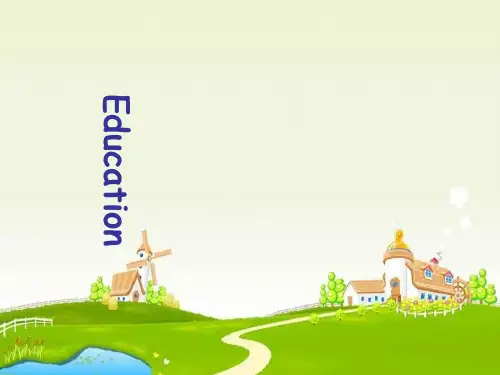
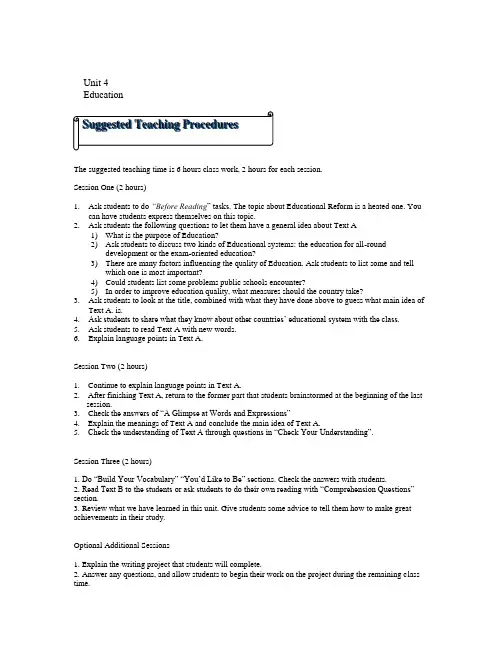
Unit 4EducationThe suggested teaching time is 6 hours class work, 2 hours for each session.Session One (2 hours)1.Ask students to do “Before Reading” tasks. The topic about Educational Reform is a heated one. Youcan have students express themselves on this topic.2.Ask students the following questions to let them have a general idea about Text A1)What is the purpose of Education?2)Ask students to discuss two kinds of Educational systems: the education for all-rounddevelopment or the exam-oriented education?3)There are many factors influencing the quality of Education. Ask students to list some and tellwhich one is most important?4)Could students list some problems public schools encounter?5)In order to improve education quality, what measures should the country take?3.Ask students to look at the title, combined with what they have done above to guess what main idea ofText A. is.4.Ask students to share what they know about other countries’ educational system with the class.5.Ask students to read Text A with new words.6.Explain language points in Text A.Session Two (2 hours)1. Continue to explain language points in Text A.2. After finishing Text A, return to the former part that students brainstormed at the beginning of the lastsession.3. Check the answers of “A Glimpse at Words and Expressions”4. Explain the meanings of Text A and conclude the main idea of Text A.5. Check the understanding of Text A through questions in “Check Your Understanding”.Session Three (2 hours)1. Do “Build Your Vocabulary” “You’d Like to Be” section s. Check the answers with students.2. Read Text B to the students or ask students to do their own reading with “Comprehension Questions” section.3. Review what we have learned in this unit. Give students some advice to tell them how to make great achievements in their study.Optional Additional Sessions1. Explain the writing project that students will complete.2. Answer any questions, and allow students to begin their work on the project during the remaining class time.3. As students work, provide feedback and support. Encourage students to make their own plans and to make discussions with other students.Web Resources/blogs/19833/(How_Public_Education_Cripples_Our_Kids_and_Why)/DEBATES/public_education_failure.HTM(公立学校的讨论)/library/news/aa050400a.htm(debate on the school spending)/pubtopic.htm(education policy)/Research/ressinglesex.html/student/Is_single_sex_education_better.htmlAfter studying this unit, students should be able to:Understand the controversy over single-sex education; the main crux of public education and its temporary condition in AmericaToday, formal education serves a greater percentage of the U.S. population than at any time in history. It played an important role, but still exist some problems. The influence of modern psychology and of education reformers such as John Dewey caused schools to become less formal, more relaxed, and somewhat more centered on the individual child rather than on the institution or the society. School facilities improved for most students, except perhaps in the inner cities. More money was spent on education, resulting in both a general upgrading of teacher salaries and improvements in programs that focus on specific kinds of students, such as special education.Besides, some members of the school reform movement believe that too little power exists at the local level. They claim that teachers and schools can increase their effectiveness only by having greater authority over such fundamental matters as curriculum content, teaching methods, and hiring of staff. Other reformers contend that not all local communities have the resources to provide quality education. They argue that to meet goals of equity and excellence, all local districts should meet high educational standards and provide ample school budgets.What’s more, in America, as for education, people hold different point of view about this question which works better: single-sex education or co-education?The conventional thinking thirty years ago was that education would break down gender stereotypes. Also, promoting equality of the sexes and eliminating gender bias have been a huge societal theme for several decades now. With that in mind coeducation which is based on that laudable theme of equality seems like the right way to go. However, some believe that coeducation does not work for every child. The same sex education is the better choice for the education of the youth of today. Since students are the potential of the future economy, it is our responsibility to provide them with best that we can. Same sex education can help, and can help a lot.Also, we know the plain truth that boys and girls learn in different ways. Research shows that a girl's brain is different from a boy's brain. One size does not fit all. Besides, some view single sex education as an opportunity to capitalize on the learning differences inherent in boys and girls.From the above, we can know that as for education in America, there is a lot of debate. With the study of Text A and Text B, let students grasp the general idea of American education.Before moving into Text A, the instructors should lead students to doing “Before Reading” and “A Glimpse at Words and Expressions” which will help warm up the students. Students’ preview of both TextA and TextB should be strongly encouraged.☞ Develop the ability of critical thinkingIn this section, one should know what is critical thinking?Critical thinking is that mode of thinking - about any subject, content, or problem - in which the thinkerimproves the quality of his or her thinking by skillfully taking charge of the structures inherent in thinkingand imposing intellectual standards upon them.Critical thinking can be seen as having two components: 1) a set of information and belief generatingand processing skills, and 2) the habit, based on intellectual commitment, of using those skills to guidebehavior.What is a good critical thinker?•raises vital questions and problems, formulating them clearly and precisely; •gathers and assesses relevant information, using abstract ideas to interpret it effectively comes to well-reasoned conclusions and solutions, testing them against relevant criteria and standards; •thinks open-mindedly within alternative systems of thought, recognizing and assessing, as need be, their assumptions, implications, and practical consequences; and • Communicates effectively with others in figuring out solutions to complex problems.Critical thinking is, in short, self-directed, self-disciplined, self-monitored, and self-correctivethinking. It presupposes assent to rigorous standards of excellence and mindful command of their use. Itentails effective communication and problem-solving abilities and a commitment to overcome our nativeAfter studying this Unit, the instructors should teach students how to read texts critically? How todevelop a habit that while reading they should hold a question mark in their mind? And with Text A andText B, the instructors should set an example to students on how to read texts in a critical way, and thenencourage students to read books after class in a critical way.☞ Extend vocabulary through recognition of prefixes of degree and sizeIn this section, the instructor should explain to the students the prefixes of degree or size. Firstly, letstudents understand the meaning of the prefixes; then encourage students to put them into practice, teachingthem how to make up new words by adding such prefixes to original words. Through learning this section,instructors should cultivate the students to develop a habit that while encountering strange words, theyshould analyze the formation of the word to guess its meaning and in addition, teach students how to useprefixes of degree or size to enlarge their vocabulary. Instructors could teach prefixes of degree or size withexercises in “Building Your Vocabulary ”.1. Browse the Websites, /usaeducationsystem.htm, and try to get familiarwith the development of American Education System . 2. The instructors should introduce some good American newspapers to students such as USA Today,New York Times, Los Angeles Times, Washington Post, etc or some websites and read articles: for example /~cma8660/mirror//chapters/.After students search some material related to this Unit, the instructor should allow them to find theirpartners to have a discussion about the Education in America.e L e a a r r n n i i n n g gA Glimpse at Words and ExpressionsPlease read the following sentences. Pay attention to the underlined part in each sentence and see how these expressions are used in the context, and then write down their meanings in the blanks provided.1. Academic standards have sunk out of sight. (have decreased or even disappeared).2. When those poor results are recognized, the system and its defenders can be counted on to say that the problem is insufficient spending. ( sure that sth will be happen)3. Reich argues that while public school systems in affluent areas are turning out students who are college or work-ready because they have le arned “to identify and solve new problems, recognize patterns, and think critically,” schools in poorer areas are not able to do that. ( are making or producing)4. Therefore we have to do something to equalize spending so that all students will have an equal shot at a good education. ( the act of trying to do or achieve sth)5. We know that because there are many nongovernmental schools in poor urban areas that produce remarkably skilled graduates, despite the fact that they operate on shoestring budgets. (run nongovernmental schools with little money)6. He wants to do away with local property taxes to fund public education and institute a national wealth tax instead.(to make sth end)7. People are entitled to do what they want with their own income or wealth. ( given the right to have or to do)8. Education establishment’s appetite for money is unending, and once the camel had its nose inside the wealth-tax tent, it would continue pushing in.(it is a metaphor, meaning that once the Educational Institutions got the national wealth tax)9. The late Peter Bauer used to point out that foreign aid did far more to prop up tyrannical regimes that to help hungry people. (to help sth that is having difficulties)An introduction to Text AThe title of Text A points out its main theme that this text mainly concerns the issue whether national wealth tax should fund Education or not. And with the comparison of public education and nongovernmental education, this text states that the amount of money put into education is not in proportion to the education’s quality. In addition, it also mentions the problems besetting the public education and provides some solutions.Suggested explanations on Text A1. While some students graduate from public schools with sharp intellectual skills (often owing more to their home environment than to their school instruction), many others drift aimlessly through 12 years of classes where little is expected of them, academic standards have sunk out of sight, and discipline is a joke. “While”(used at the beginning of the sentence)The usages of “while”1) as the conj.a.during the time that sth is happening.eg (1) we have run into many famous stars while (we are) in BeiJing.(2) While I was waiting at the bus stop, three buses went by in the opposite direction.b. at the same time as sth else is happening.eg The burglar is decoding my safe while I unlock the door.c.. used to contrast two things.eg (1) While Jacky is well versed in mathematics, his sister is absolutely hopeless.(2)Other men live to eat, while I eat to live.2)as noun.a period of timeeg Every time I always wait for quite a while in order to get the cheapest goods.3) as verbThe phrase “while sth away” : to spend time in a pleasant lazy way.eg Every day, he whiled away the time playing cards and watching TV.graduate from: to complete a course in education especially at high school.eg She graduated from that famous high school.graduate (in sth) from sth: to get a degree, especially your first degree, from your university or college. eg She graduated from Harvard with a degree in psychology.2. many others drift aimlessly through 12 years of classes where little is expected of them,…….to drift (verb): to happen or change or to do sth without a particular plan or purposeeg I didn’t intend to be a teacher----I just drifted into it.to drift (verb): to move along smoothly and slowly in water or aireg Thousands of lanterns slowly drift out to sea guiding the dead on their return journey to the other world.to drift (verb): to move or go somewhere slowlyeg people drifted away from the scene of the accident.3. ……and discipline is a joke.discipline (noun) the practice of training people to obey rules and orders and punishing them if they do not; the controlled behavior or situation that results from this trainingeg 1) Stern discipline did not achieve the desired result.2) Strict discipline does not always work in terms of developing children's personal qualities. Too much pressure on children leads to rebellion and other extreme actions.to discipline (verb): to train sb, especially a child, to obey particular rules and control the way they behaveeg Schools try their best to take measures to discipline the students.to discipline yourself: to control the way you behave and make yourself do things that you believe you should doeg You must discipline yourself to finish your work on time.4. Thanks to strict state licensing laws, it is almost obligatory for anyone who wants to teach in public schools to go through a lengthy course of study in a college or university “school of education, “where the emphasis is on dubious pedagogical theories such as cooperative learning and multicultural sensitivity rather than on the mastery of subject matter and how best to impart that knowledge to students.thanks to (followed by the sb/sth), used to say that sth has happened because of sb/sth.eg Thanks to our clever leader, our company avoided going bankruptcy.It is for sb to do stheg It is for you to do the thorough cleaning.impart sth to sb/sth to pass information, knowledge etc to other peopleeg I have no news to impart (to you).rather thaneg We are to blame rather than they.The usages of “rather than”rather than 可作连词词组使用,连接两个并列成分,表示在两者中间进行选择,意为“是A 而不是B ”、“要A 不要B ”、“宁愿A 而不愿B ”等,后面可以接名词、代词、形容词、副词、动词和动词不定式等。
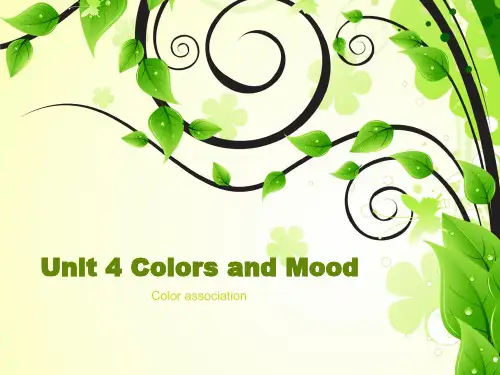
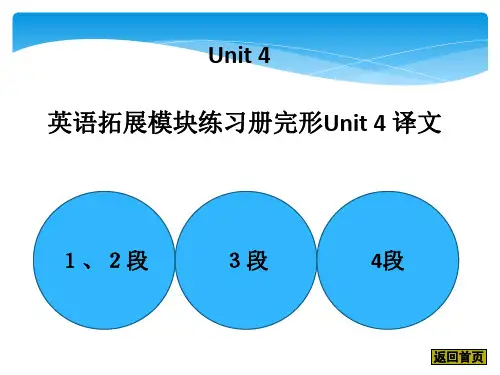
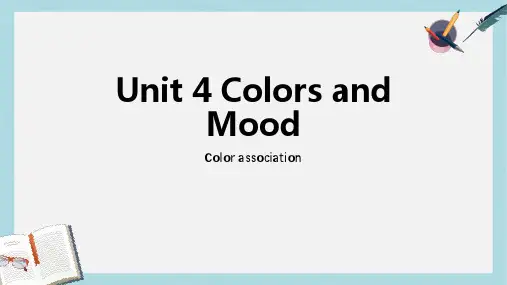
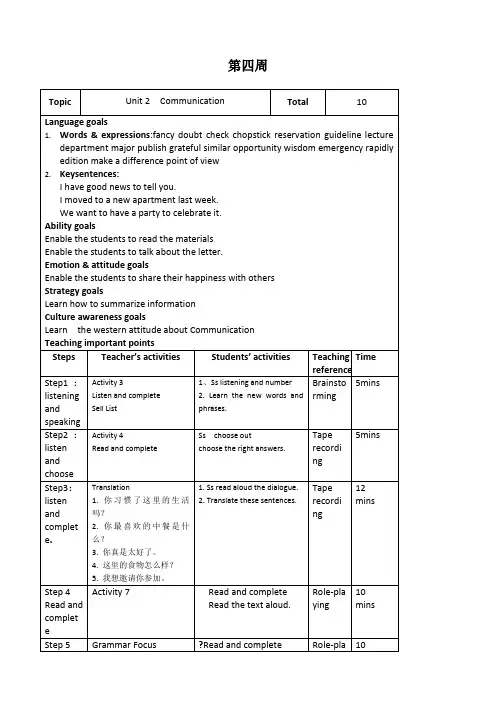
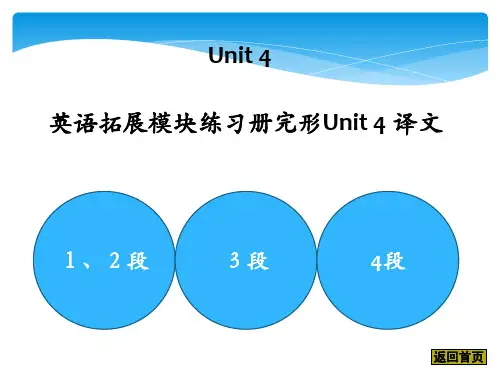
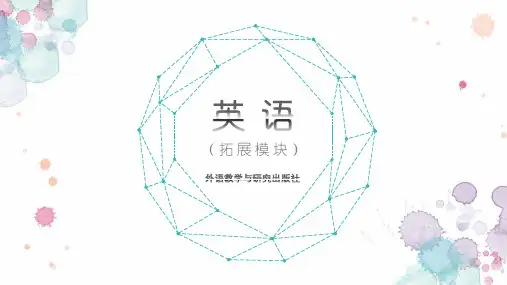
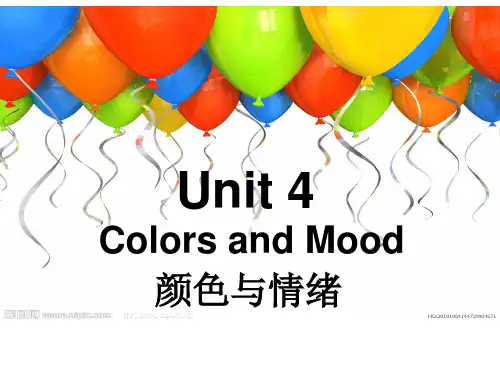
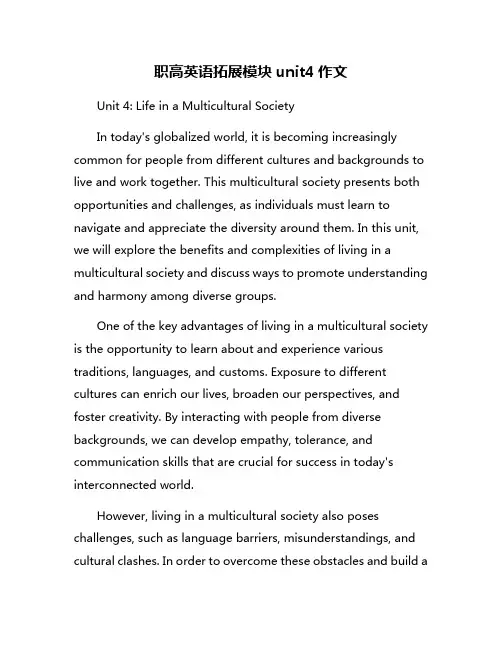
职高英语拓展模块unit4作文Unit 4: Life in a Multicultural SocietyIn today's globalized world, it is becoming increasingly common for people from different cultures and backgrounds to live and work together. This multicultural society presents both opportunities and challenges, as individuals must learn to navigate and appreciate the diversity around them. In this unit, we will explore the benefits and complexities of living in a multicultural society and discuss ways to promote understanding and harmony among diverse groups.One of the key advantages of living in a multicultural society is the opportunity to learn about and experience various traditions, languages, and customs. Exposure to different cultures can enrich our lives, broaden our perspectives, and foster creativity. By interacting with people from diverse backgrounds, we can develop empathy, tolerance, and communication skills that are crucial for success in today's interconnected world.However, living in a multicultural society also poses challenges, such as language barriers, misunderstandings, and cultural clashes. In order to overcome these obstacles and build aharmonious community, it is important to promote mutual respect, open-mindedness, and intercultural dialogue. By cultivating a culture of inclusivity and acceptance, we can create a more welcoming and unified society where everyone feels valued and respected.To enhance our understanding of multiculturalism and promote social cohesion, we can engage in activities that celebrate diversity, such as cultural festivals, language exchanges, and community events. By participating in these initiatives, we can break down stereotypes, build bridges between different groups, and foster a sense of unity and belonging.In conclusion, living in a multicultural society offers a wealth of opportunities for personal growth, cultural enrichment, and social cohesion. By embracing diversity, promoting understanding, and fostering inclusivity, we can create a more vibrant, tolerant, and harmonious community where everyone can thrive. Let us strive to build a world where differences are celebrated, and where unity and respect prevail.。
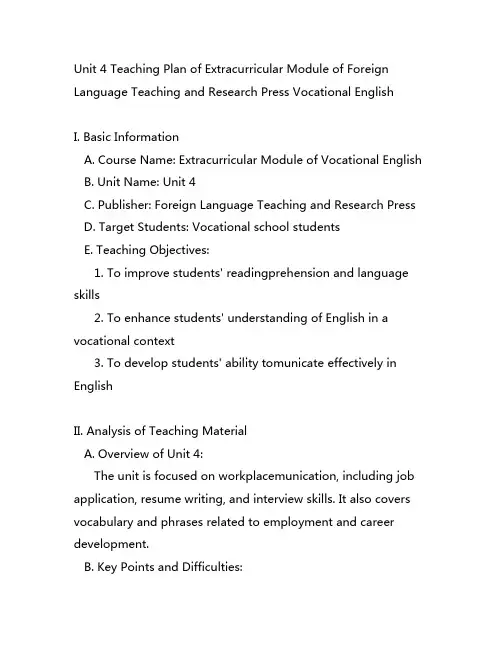
Unit 4 Teaching Plan of Extracurricular Module of Foreign Language Teaching and Research Press Vocational EnglishI. Basic InformationA. Course Name: Extracurricular Module of Vocational EnglishB. Unit Name: Unit 4C. Publisher: Foreign Language Teaching and Research PressD. Target Students: Vocational school studentsE. Teaching Objectives:1. To improve students' readingprehension and language skills2. To enhance students' understanding of English in a vocational context3. To develop students' ability tomunicate effectively in EnglishII. Analysis of Teaching MaterialA. Overview of Unit 4:The unit is focused on workplacemunication, including job application, resume writing, and interview skills. It also covers vocabulary and phrases related to employment and career development.B. Key Points and Difficulties:1. Understanding and using professional vocabulary and expressions2. Mastering job application and interview skills3. Improving readingprehension and writing ability in a vocational contextIII. Teaching StrategiesA. Task-based Learning:Engage students in role-plays, group discussions, and real-life scenarios to practice workplacemunication skills.B. Multimedia Teaching:Utilize audio and video resources to provide authentic English language input and to stimulate students' interest.C. Interactive Teaching:Encourage students to participate in class activities, ask questions, and share their thoughts and experiences.IV. Det本人led Teaching PlanA. Pre-reading Activities:1. Warm-up: Discuss students' aspirations and career goals.2. Vocabulary Preview: Introduce key terms related to employment and job interviews.B. While-reading Activities:1. Reading Comprehension: In-class reading of an authentic job advertisement or interview transcript.2. Language Practice: In-class exercises to practice using professional language and expressions.C. Post-reading Activities:1. Role-play: Perform mock job interviews or simulate workplace interactions.2. Discussion: Reflect on the reading and share personal insights on the topic.V. Evaluation and AssessmentA. Formative Assessment:1. In-class participation and engagement2. Completion of readingprehension exercisesB. Summative Assessment:1. Written assignment: Resume writing or cover letter drafting2. Oral assessment: Role-played job interviewsVI. Extension and HomeworkA. Self-study:Encourage students to explore additional reading materials on job application and career development.B. Homework Assignments:1. Vocabulary Review: Memorize and practice using new workplace-related vocabulary.2. Writing Practice: Complete a draft of a resume or cover letter for a specific job posting.VII. Reflection and FeedbackA. Class Reflection:Discuss the effectiveness of the teaching strategies and activities used in the unit.B. Student Feedback:Encourage students to provide honest feedback on the unit, including their learning experience and any challenges faced.VIII. ConclusionA. Summary of Teaching Objectives:The unit 本人ms to equip students with practical workplacemunication skills and enhance their English language proficiency in a professional context.B. Future Directions:Continuously improve and adapt teaching materials and strategies based on student feedback and the evolving needs of vocational English learners.In conclusion, the teaching plan for Unit 4 of the Extracurricular Module of Foreign Language Teaching and Research Press Vocational English is designed to engage students in real-life workplacemunication scenarios, improve their English language skills, and provide them with practical tools for career development. Through abination of task-based learning, multimedia teaching, and interactive classroom activities, this unit 本人ms to equip students with the necessary language proficiency and confidence to succeed in their future careers.。